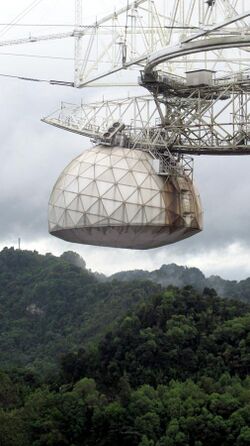Astronomy:Coqui (NASA)
The Coquí and Coquí II (Coquí Dos and Coquí 2) campaign involved a sequence of sounding rocket launches in order to study the dynamics of the E- and F-region ionosphere and increase scientists' understanding of layering phenomena, such as sporadic E layers. The studies were supported by the United States' National Aeronautics and Space Administration (NASA) and carried out in 1992 and 1998 respectively.[1]
NASA launched sounding rockets from the Puerto Rican coastal town of Vega Baja, about 20 miles west of San Juan. Among the stated goals were to study how the Earth's ionosphere reacts to naturally occurring phenomena by artificially simulating these phenomena using a high-frequency (HF) radar and study the ionospheric response with both the Arecibo Observatory ionospheric radar and with instruments and chemical tracers carried aboard the sounding rockets. The campaign was named for the coqui frog, which is a small frog in the genus Eleutherodactylus native to Puerto Rico.[2]
The launches which took place from the Tortuguero Launch Range,[3] near Tortuguero Lagoon sparked protests.[4][5][6]
References
- ↑ "NASA Facts: Coqui Dos". https://www.nasa.gov/centers/goddard/pdf/106040main_coquidos.pdf.
- ↑ Friedlander, Blaine (November 14, 1997). "Research rockets, including an experiment from Cornell, are scheduled for launch into the ionosphere next year from Puerto Rico". https://news.cornell.edu/stories/1997/11/research-rockets-including-experiment-cornell-are-scheduled-launch-ionosphere-next.
- ↑ Pfaff, R.F.; Acuna, M.; Bounds, S.; Freudenreich, H.; Clemmons, J.; Earle, G.; Heelis, R.; Kudeki, E. et al. (March 24, 1998). "Rocket/Radar Sporadic-E Experiment Conducted during the El Coqui 2 Campaign". https://ntrs.nasa.gov/citations/19990067828.
- ↑ Corrales, Scott (May 25, 1992). "NASA Gets Coqui". https://www.umsl.edu/~thomaskp/nacoq.htm.
- ↑ "NASA project spurs Puerto Rico protests". Associated Press. February 21, 1998. https://www.deseret.com/1998/2/21/19364818/nasa-project-spurs-puerto-rico-protests.
- ↑ Ruiz, Carmelo (May 1, 2001). "Puerto Rico Actions". http://www.globenet.free-online.co.uk/actions/prico2.htm.
External links
- Resource Center of the Americas: NASA Experiments Continue
- Long Spark Running: NASA's Coqui Experiments
 |


